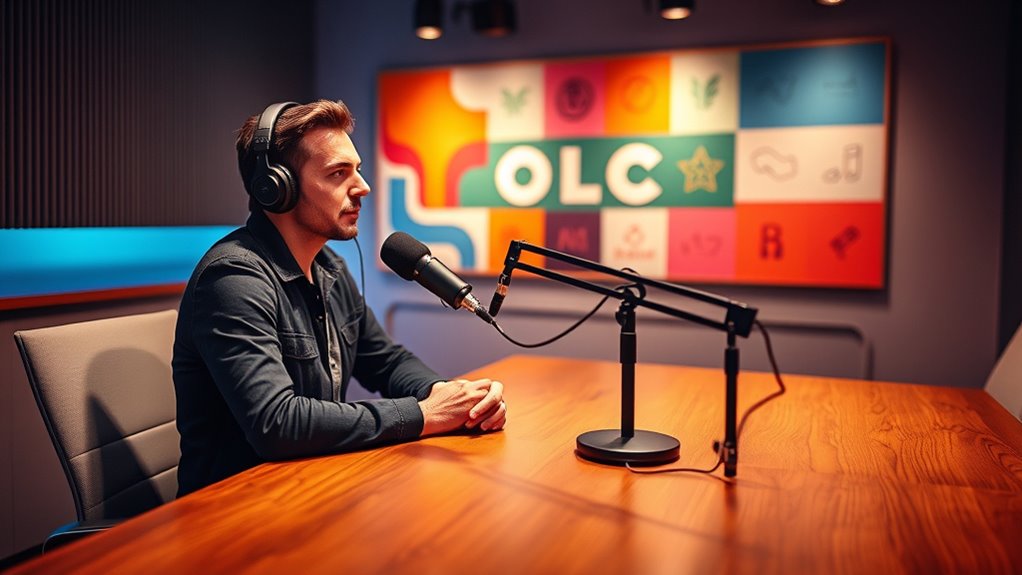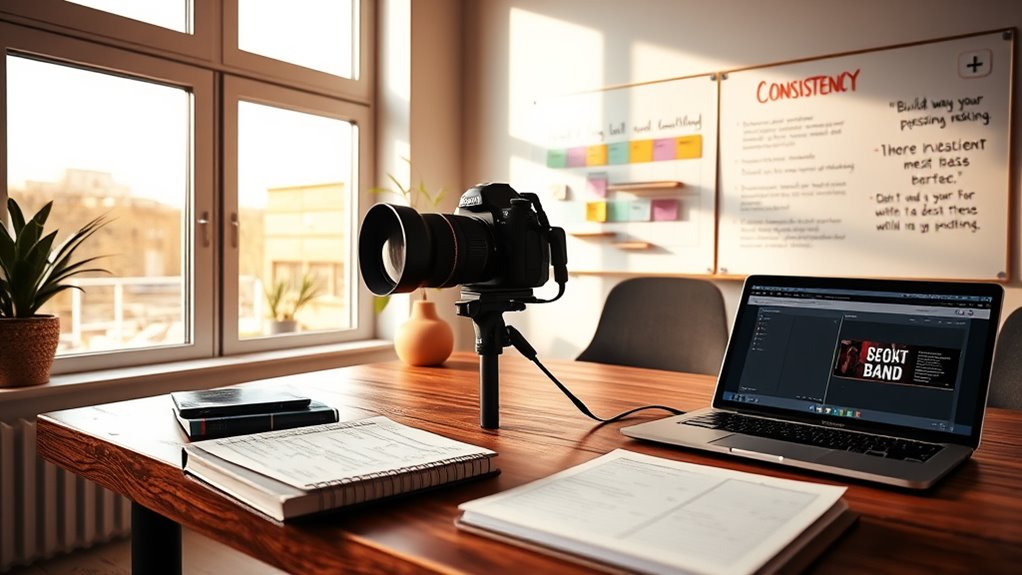To build a personal brand podcast, start by defining what makes you unique and develop a clear, consistent identity through visuals and messaging. Know your target audience and create content that reflects your brand’s values while engaging listeners with authentic storytelling. Choose quality equipment, plan a publishing schedule, and promote actively on social media. Engage with your audience for feedback, and keep refining your approach to grow steadily—there’s much more to discover along the way.
Key Takeaways
- Define a unique brand identity with visual storytelling and consistent messaging to reflect your personality and values.
- Identify and understand your target audience to tailor content that resonates and builds genuine connections.
- Plan and produce content aligned with your brand, selecting suitable equipment and setting up an engaging, professional space.
- Promote your podcast through social media, collaborations, and regular publishing schedules to grow your audience.
- Engage with listeners, gather feedback, and analyze metrics to refine your strategy and strengthen your personal brand.
Defining Your Unique Brand Identity

Have you ever wondered what makes your brand stand out in a crowded marketplace? Defining your unique brand identity is key. Start with visual storytelling—use images, colors, and design elements that reflect who you are and what you stand for. Personal branding tips emphasize authenticity; showcase your personality and values consistently. Think about your voice, style, and the message you want to convey. Your brand identity should be clear and memorable, helping others instantly recognize you. By honing these elements, you create a cohesive image that resonates with your audience. Remember, your brand is more than just a logo—it’s the story you tell through visuals and words. Nail this down, and you’ll set a strong foundation for your personal brand. Incorporating consistent visual elements helps reinforce your brand identity across various platforms.
Identifying Your Target Audience

To build a podcast that resonates, you need to understand who your audience is, starting with their demographics like age and location. Think about their interests and needs so you can create content that truly engages them. Putting together detailed audience personas helps you tailor your messaging and connect more effectively. Incorporating creative storytelling techniques can further deepen audience engagement and foster lasting connections.
Audience Demographics
Understanding your target audience is essential for creating a successful personal brand podcast. To do this, you need to identify key demographic details. Imagine your listeners as:
- A group of young adults, ages 18-24, eager to learn and connect.
- Middle-aged professionals, 35-50, seeking insights to boost their careers.
- An international audience, representing diverse cultural backgrounds, bringing unique perspectives.
Knowing the age groups helps tailor your content tone and language, making it relatable. Recognizing cultural backgrounds allows you to respect differing viewpoints and avoid missteps. By understanding these demographics, you can craft episodes that resonate, ensuring your message hits home with the right people. This clarity guides your content creation, marketing, and engagement efforts effectively. Additionally, considering mental clarity and focus can help you design content that reduces overwhelm and fosters meaningful connections with your audience.
Audience Interests & Needs
What drives your audience’s engagement and keeps them coming back? Understanding listener preferences is key. You need to identify what topics resonate most, what questions they have, and what challenges they face. Paying attention to content gaps helps you craft episodes that fill unmet needs, making your podcast more valuable. By analyzing feedback, reviews, and engagement metrics, you can discover patterns in what your audience seeks. This insight allows you to tailor your content to match their interests, increase relevance, and foster loyalty. Remember, addressing their needs isn’t just about what you want to talk about but what they want to hear. Staying aligned with listener preferences ensures continuous engagement and helps build trust in your personal brand. Incorporating content strategies based on proven engagement techniques can further enhance your podcast’s appeal.
Creating Audience Personas
Creating audience personas is an essential step in building a successful personal brand podcast because it helps you pinpoint exactly who your ideal listeners are. By focusing on audience segmentation, you can group your audience based on shared traits, making your content more targeted. To develop these personas, imagine your audience as:
- A busy professional seeking quick, actionable insights
- An aspiring creator enthusiastic to learn from your experiences
- A curious learner interested in personal growth stories
- Understanding your audience’s content preferences enables you to craft more engaging episodes.
Planning Content That Reflects Your Brand

To create content that truly represents your brand, start by defining your core message so your audience knows what you stand for. Make sure your topics align with your brand values to build trust and consistency. Keep your tone steady across episodes to reinforce your identity and make your podcast recognizable.
Define Your Core Message
Have you ever wondered how to guarantee your podcast consistently reflects your unique brand? The key is defining your core message. This message should serve as the foundation for your brand storytelling, guiding every episode. To create clarity, picture these three elements:
- Your mission statement, capturing what you stand for
- Your target audience’s needs and interests
- Your visual branding cues that reinforce your message
Additionally, understanding color accuracy can help ensure your branding visuals are consistent and compelling across all platforms.
Align Topics With Brand Values
Ever wondered how to guarantee your podcast topics consistently reflect your brand values? The key is aligning your content with your brand storytelling and visual identity. When you choose topics, ask yourself if they reinforce your core message and showcase what makes your brand unique. Your stories should resonate with your audience while maintaining consistency with your visual identity, such as color schemes, logos, and design elements. This alignment helps build trust and recognition, making your podcast a true extension of your brand. Stay true to your values by selecting subjects that highlight your expertise and reflect your personality. When your content mirrors your brand’s essence, it creates a cohesive experience that attracts and retains loyal listeners. Additionally, understanding your audience’s interests can be enhanced by researching Beauty Hours Today List, ensuring your topics are timely and relevant.
Maintain Consistent Tone
Maintaining a consistent tone is essential for reinforcing your brand identity and building trust with your audience. When you focus on voice consistency, your listeners recognize your unique style and message. To achieve this, visualize your tone as: 1. A steady drumbeat that guides your content, ensuring rhythm and clarity. 2. A warm, inviting conversation that makes your audience feel comfortable and engaged. 3. An authentic voice that reflects your true personality, fostering genuine connections. Additionally, understanding your target audience and tailoring your content strategy accordingly can help you stay aligned with your brand’s voice and effectively resonate with your listeners.
Choosing the Right Podcast Format and Style

Choosing the right podcast format and style is essential because it shapes how your audience connects with your content. Your format influences the tone, pacing, and overall experience for listeners. If you prefer engaging conversations, consider interview formats, where you invite guests to share their insights. This approach can add credibility and variety to your show. Alternatively, solo episodes allow you to share your expertise directly, creating a personal connection with your audience. Think about what feels most authentic to you and what will resonate with your target listeners. Consistency is key, so choose a style you can maintain comfortably while providing value. Additionally, understanding market dynamics and audience preferences can help tailor your content to meet current trends and expectations. By selecting the right format, you’ll set a solid foundation for your personal brand podcast that keeps your audience engaged and coming back for more.
Selecting Quality Equipment and Setting Up Your Space

Selecting quality equipment and setting up your space are essential steps to guarantee your podcast sounds professional and engaging. First, choose the right microphone—consider a dynamic or condenser mic suited to your voice and environment. Next, focus on acoustic treatment: add foam panels or blankets to absorb echo and background noise. Finally, arrange your space for comfort and clarity, ensuring minimal distractions. To visualize: 1. Picture yourself speaking confidently into a high-quality microphone that captures every nuance. 2. Imagine your room with sound-absorbing panels, creating a quiet, professional atmosphere. 3. Envision a clean, organized desk with your equipment ready, so you can focus solely on delivering your message. Proper microphone selection and acoustic treatment turn a simple space into a recording studio, elevating your podcast’s sound quality and credibility. Incorporating rustic decor elements can also add warmth and character to your recording environment, making it more inviting and inspiring.
Developing a Consistent Publishing Schedule

Once you’ve set up a professional-looking space with quality equipment, the next step is to establish a steady rhythm for your episodes. Creating a content calendar helps you plan your topics and stay organized, ensuring consistency. Decide on a publishing frequency that fits your schedule—whether weekly, biweekly, or monthly—and stick to it. Consistency is key to building audience trust and maintaining engagement. Use your content calendar to map out deadlines, recording dates, and release days, so you stay on track. Setting a predictable publishing schedule makes it easier for listeners to anticipate new episodes and keeps your personal brand top of mind. Regular uploads also signal reliability, encouraging your audience to tune in regularly.
Promoting Your Podcast to Grow Your Reach

How can you guarantee more people discover your podcast? Focus on strategic promotion techniques. First, leverage guest collaborations by inviting influential guests who can share your show with their audiences. This expands your reach and builds credibility. Second, actively promote your episodes on social media platforms. Use eye-catching graphics, engaging captions, and relevant hashtags to attract attention. Third, encourage your guests and listeners to share episodes, creating a ripple effect. Consistent social media promotion keeps your podcast visible in feeds and stories, drawing in new listeners. Combining guest collaborations with targeted social media efforts maximizes exposure. By implementing these tactics, you ensure your podcast reaches a broader audience and gains momentum in building your personal brand.
Engaging With Your Audience for Feedback and Growth

Engaging with your audience is essential for understanding their preferences and fostering loyalty. By actively seeking listener feedback, you show that you value their input and want to create content that resonates. Encourage audience engagement through social media, comments, or polls, making it easy for listeners to share their thoughts. Responding to feedback not only builds trust but also helps you tailor your episodes to meet their interests. When you listen to your audience, you gain insights that can inspire new topics and improve your podcast’s quality. Consistently engaging with your listeners creates a community that feels connected and invested in your growth. Remember, the more you connect with your audience, the more they’ll support and promote your personal brand.
Measuring Success and Refining Your Strategy

To guarantee your podcast is heading in the right direction, it’s essential to regularly measure its performance and analyze the data you gather. Start by reviewing analytics metrics like downloads, listener retention, and engagement rates to identify what’s resonating. Next, conduct feedback surveys to gain direct listener insights and uncover areas for improvement. These tools help you:
Regularly analyze analytics and gather listener feedback to refine your podcast’s success.
- Visualize listener growth and identify trends over time.
- Pinpoint episodes that perform best and replicate their success.
- Adjust content, format, or promotion strategies based on concrete data.
Frequently Asked Questions
How Do I Monetize My Personal Brand Podcast Effectively?
You can monetize your podcast effectively by securing sponsorship deals that align with your audience’s interests, increasing your revenue. Additionally, promote merchandise sales like branded gear or digital products to engage your listeners and boost income. Focus on growing your audience to attract better sponsorships and create a loyal community that’s enthusiastic to support your brand through purchases. Consistent content and authentic engagement will maximize your monetization potential.
What Legal Considerations Should I Keep in Mind?
When managing your personal brand podcast, you need to consider legal aspects like intellectual property and privacy rights. Always ensure you have permission to use copyrighted content, such as music or clips. Respect privacy rights by obtaining consent before sharing personal information or interviews. Stay aware of legal regulations to avoid potential disputes, and consider consulting a legal expert to protect your content and maintain compliance.
How Can I Collaborate With Other Podcasters?
Think of collaboration as a dance where both partners shine. You can approach other podcasters for guest collaboration, offering to share expertise or stories. Cross promotion is like passing the baton—each of you promotes the other’s episodes to tap into new audiences. Reach out via email or social media, be genuine, and propose mutual benefits. This teamwork builds your network and boosts visibility, making your podcast stronger together.
What Are Common Mistakes to Avoid in Branding a Podcast?
When branding your podcast, avoid common pitfalls like inconsistent messaging or overhyping content, which can cause audience disconnect. Don’t neglect your target audience’s preferences or create a confusing identity. Keep your branding authentic and clear, ensuring it reflects your podcast’s core message. Staying true to your brand helps build trust and loyalty, preventing branding pitfalls that could undermine your growth. Remember, consistency and authenticity are key to connecting with your audience.
How Do I Handle Negative Feedback Professionally?
When handling negative feedback, you should approach it with professionalism to enhance listener engagement and improve your brand. Acknowledge the feedback promptly, thank the listener for sharing their thoughts, and respond calmly. Use feedback management techniques to address concerns constructively, showing you’re committed to growth. This approach not only demonstrates maturity but also builds trust, encouraging more honest communication and strengthening your personal brand.
Conclusion
Building a personal brand podcast is your ticket to standing out in today’s crowded digital sphere. Stay authentic, plan your content wisely, and keep engaging with your audience—like a modern-day Socrates, but with a mic. Remember, consistency and quality are your best allies on this journey. So, hit record, be yourself, and watch your brand grow faster than a Tesla in autopilot mode. Your future listeners are waiting—go make your mark!









